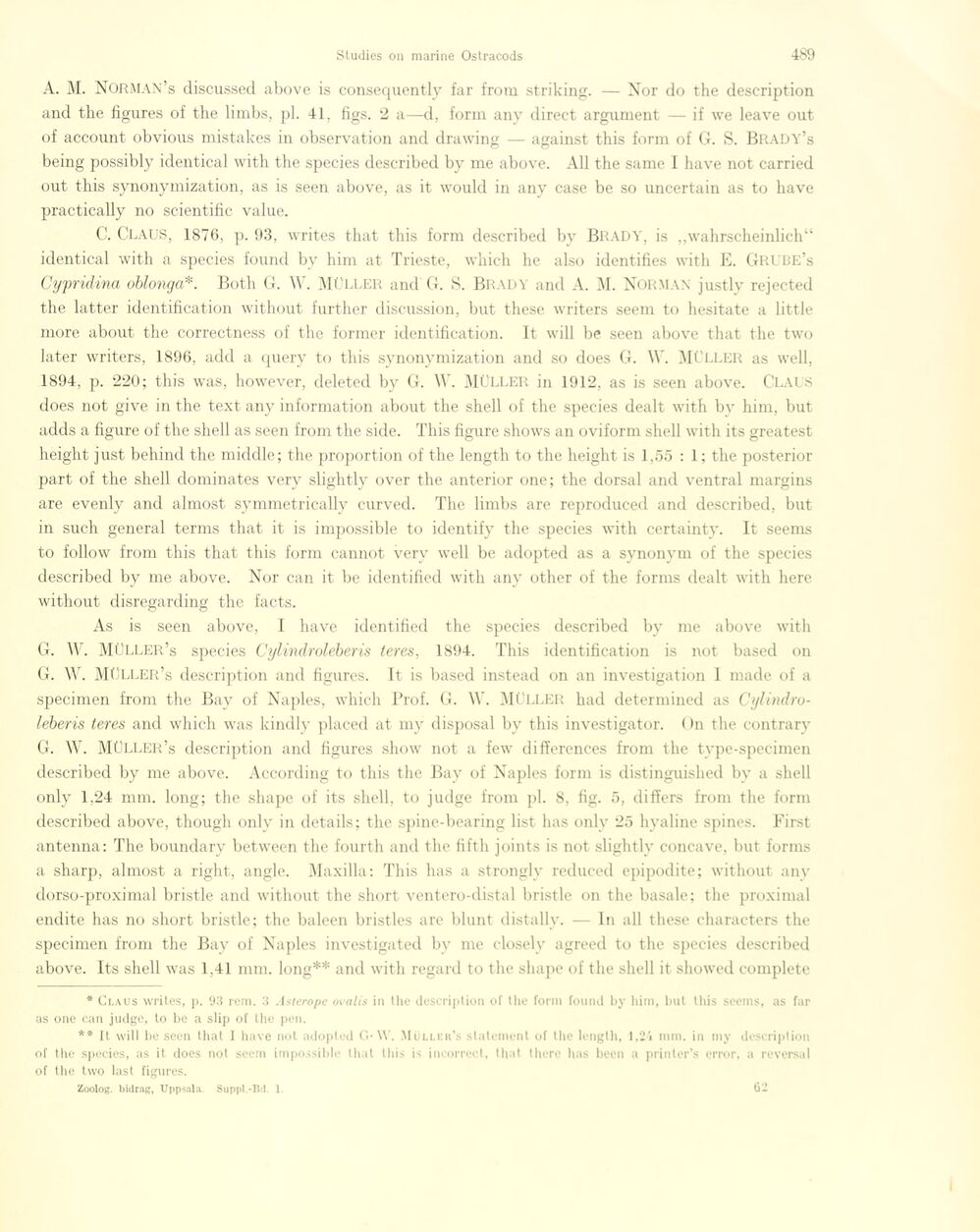
Full resolution (JPEG) - On this page / på denna sida - Sidor ...

<< prev. page << föreg. sida << >> nästa sida >> next page >>
Below is the raw OCR text
from the above scanned image.
Do you see an error? Proofread the page now!
Här nedan syns maskintolkade texten från faksimilbilden ovan.
Ser du något fel? Korrekturläs sidan nu!
This page has never been proofread. / Denna sida har aldrig korrekturlästs.
A. M. NORMAN’s discussed above is consequently far from striking. — Nor do the description
and the figures of the limbs, pl. 41, figs. 2 a—d, form anv direct argument — if we leave out
of account obvions mistakes in observation and drawing — against this form of G. S. BRADY’s
being possibly identical with the species described by me above. All the same I have not carried
out this synonymization, as is seen above, as it would in any case be so uncertain as to have
practically no scientific value.
C. CLAUS, 1876, p. 93, writes that this form described by Brady, is „wahrscheinlich“
identical with a species fourni by him at Trieste, which he also identifies with E. GRUBE’s
Cypridina oblonga*. Both G. W. Müller and G. S. Brady and A. M. Norman justly rejected
the latter identification without further discussion, but these writers seem to hesitate a little
more about the correctness of the former identification. It will be seen above that the two
later writers, 1896, add a query to this synonymization and so does G. W. MÜLLER as well,
1894, p. 220; this was, however, deleted by G. \Y. MÜLLER in 1912, as is seen above. CLAUS
does not give in the text any information about the shell of the species dealt with by him, but
adds a figure of the shell as seen from the side. This figure shows an oviform shell with its greatest
height just behind the middle; the proportion of the length to the height is 1,55 : 1; the posterior
part of the shell dominâtes very slightly over the anterior one; the dorsal and ventral margins
are evenly and almost symmetrically curved. The limbs are reproduced and described, but
in such general terms that it is impossible to identify the species with certainty. It seems
to follow from this that this form cannot very well be adopted as a synonym of the species
described by me above. Nor can it be identified with any other of the forms dealt with liere
without disregarding the facts.
As is seen above, I have identified the species described by me above with
G. W. MUller’s species Cylindroléberis teres, 1894. This identification is not based on
G. W. MÜLLER’s description and figures. It is based instead on an investigation 1 made of a
specimen from the Bay of Naples, which Prof. G. W. MÜLLER had determined as
Cylindroléberis teres and which wTas kindly placed at my disposai by this investigator. On the eontrary
G. W. MÜLLER’s description and figures show not a few differences from the type-specimen
described by me above. According to this the Bay of Naples form is distinguished by a shell
only 1,24 mm. long; the shape of its shell, to judge from pl. 8, fig. 5, differs from the form
described above, though only in details; the spine-bearing list has only 25 hyaline spines. First
antenna: The boundary between the fourth and the fifth joints is not slightly concave, but forms
a sharp, almost a right, angle. Maxilla: This has a strongly reduced epipodite; without any
dorso-proximal bristle and without the short ventero-distal bristle on the basale; the proximal
endite has no short bristle; the baleen bristles arc blunt distally. — In all these characters the
specimen from the Bay of Naples investigated by me closely agreed to the species described
above. Its shell was 1,41 mm. long** and with regard to the shape of the shell it showed complete
* Claus writes, p. 93 rem. 3 Asterope ovalis in the description of the form fonnd by him, but this seems, as far
as one can judge, to be a slip of the pen.
** It will be seen that I have not adopted G- W. Müller’s statement of the length, 1,21 mm. in my description
of the species, as it does not seem impossible that this is incorrect, tliat tlierc has been a printer’s error, a reversal
of the two last figures.
Zoolog, bidrag, Uppsala. Suppl.-Bd. 1. 62
<< prev. page << föreg. sida << >> nästa sida >> next page >>